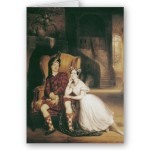 Largely speaking, there are two versions of La Sylphide that are performed today.
Largely speaking, there are two versions of La Sylphide that are performed today.
One is the arguably better known Bournonville version which was premiered in 1836. This, however, is said to be a version inspired by Filippo Taglioni’s original which was premiered in 1832 to Schneizhoeffer’s music at Paris Opera.
Filippo Taglioni was the father of the famed Marie Taglioni, who seems to have been quite a stage papa! He was a dancer and choreographer himself but saw that his daughter, Marie, did not look the typical part of a prima ballerina of the day. Marie was slight and had very rounded shoulders but rather than to disguise her physique, which was not “ideal” image of a ballerina then, Filippo decided to just enhance her strong points and created what we now call a Romantic ballet style. We can still see the image of Taglioni in the Romantic style itself, i.e. very slightly forward inclined neckline, rounded shoulders and very light footwork.
It is said that August Bournonville watched Taglioni’s version while he was in Paris and wanted to bring it back as his repertoire when he was returning to his native land Denmark, but as he could not get a permission, he commissioned music to Lovenskjold and created his own version, that established his fame and style which is handed down through generations in Denmark to this day.
In 1972 Pierre Lacotte revived the Taglioni version for Paris Opera Ballet for his wife, Ghislaine Thesmar, and this version is still performed by companies such as Paris Opera Ballet and Tokyo Ballet Company.
Whereas in the Bournonville version there is hardly any partnering showing that the Sylph cannot get caught, Lacotte version is based a lot more on partnering which enhances the lightness of the ballerina.
The plot is a fairly typical of ballet. James, a Scottish farmer is to wed Effie, but Gurn is also in love with Effie. While they celebrate the upcoming nuptial, an old witch Madge comes in and offer to read people’s palms for their future. When she tells Effie that she was not to marry James, but she would marry Gurn, James gets angry and throws Madge out. This is, as always is the case of such stories, is the beginning of the tragedy. When Effie goes to get dressed in the bridal attire, a Sylph comes into the house and lures James out into the woods.
The second act takes place in the woods and starts off with Madge making a poisoned scarf for the Sylph. Beautiful dance of the Sylph with corp de ballet, and James’ dance make up a large part of the second act. Eventually Madge tells James, who is frustrated with the Sylph as she would not easily come to him, that if he gives the Sylphide the scarf she made, she will no longer be able to fly away from him. James takes the scarf and wraps it around the Sylphide only to find that her wings fall out and she dies. In the end, the heartbroken James sees his fiancé Effie in her own wedding procession to Gurn.
It is a beautiful ballet, almost synonym to Romantic ballet itself. The pas de deux in the second act is often danced on its own in concerts and James’ solos are often the chosen numbers in competitions.
History or pointe shoes, and dancers who are well known for their Romantic ballet will be saved for another time!
